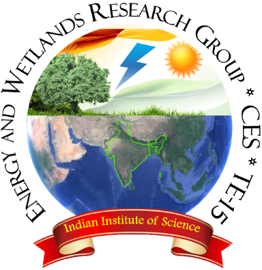 |
Simulating urban growth by two state modeling and connected network |
 |
|
Study Area
Bangalore is geographically located at the south-eastern part of India and capital of Karnataka state is considered as a study area along with a circular buffer of 10 km, (Fig. 1) with spatial extents from 12°49′5″N to 13°8′32″N latitude
 and 77° 27 ′29″ E to 77°47′2″E in longitude encompassing an area of 741 km2. Ten km buffer from the administrative boundary was considered (with a gross area of 2290 km2) to account for developments in the peri-urban regions. Popula-tion as per the census of Govt. of India has increased by 44% in a decade from 5.8 million in 2001 to 8.5 in 2011 at a rate of 4.4% annually, higher than the national average of 2.5%.
and 77° 27 ′29″ E to 77°47′2″E in longitude encompassing an area of 741 km2. Ten km buffer from the administrative boundary was considered (with a gross area of 2290 km2) to account for developments in the peri-urban regions. Popula-tion as per the census of Govt. of India has increased by 44% in a decade from 5.8 million in 2001 to 8.5 in 2011 at a rate of 4.4% annually, higher than the national average of 2.5%.
|
Citation : Bharath H. Aithal, S. Vinay, T. V. Ramachandra, 2018. Simulating urban growth by two state modelling and connected network. Modeling Earth Systems and Environment. © Springer Nature Switzerland AG 2018. Received: 30 April 2018 / Accepted: 11 August 2018. https://doi.org/10.1007/s40808-018-0506-1
|
Bharath.H Aithal
RCG School of Infrastructure Design and Management, IIT Kharagpur, West Bengal, India
Energy and Wetland Research Group, Centre for Ecological Science, IISc, Bangalore, India
S.Vinay
Energy and Wetland Research Group, Centre for Ecological Science, IISc, Bangalore, India
Dr. T.V. Ramachandra
Centre for Sustainable Technologies, Centre for infrastructure, Sustainable Transportation and Urban Planning (C iSTUP),
Energy & Wetlands Research Group, Centre for Ecological Sciences, Indian Institute of Science, Bangalore – 560 012, INDIA.
E-mail : cestvr@ces.iisc.ac.in
Tel: 91-080-22933099/22933503 (extn 107)
Fax: 91-080-23601428/23600085
Web: http://ces.iisc.ac.in/energy
Citation: Bharath H. Aithal, S. Vinay, T. V. Ramachandra, 2018. Simulating urban growth by two state modelling and connected network. Modeling Earth Systems and Environment. © Springer Nature Switzerland AG 2018. Received: 30 April 2018 / Accepted: 11 August 2018. https://doi.org/10.1007/s40808-018-0506-1
|


